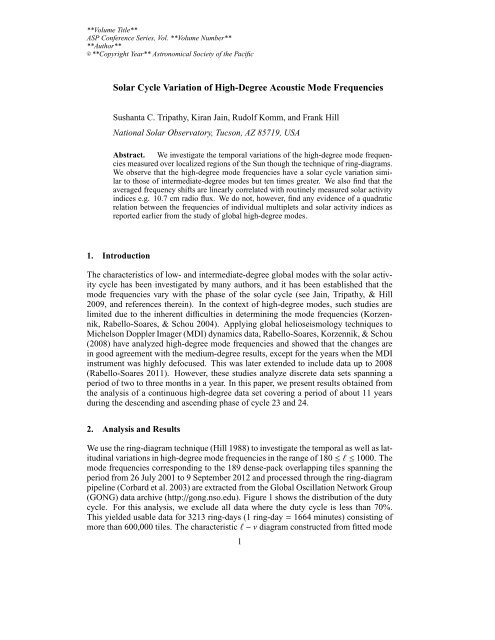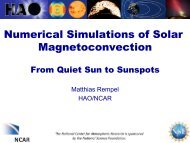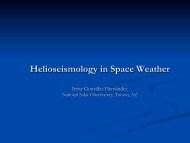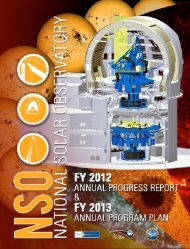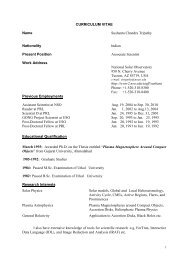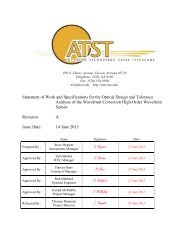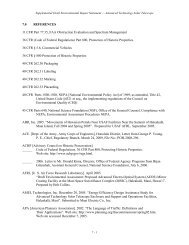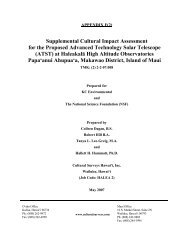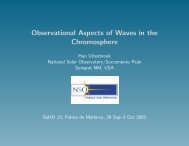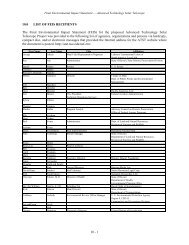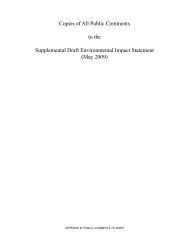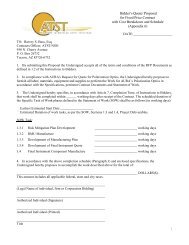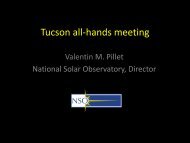Presentation - National Solar Observatory
Presentation - National Solar Observatory
Presentation - National Solar Observatory
Create successful ePaper yourself
Turn your PDF publications into a flip-book with our unique Google optimized e-Paper software.
**Volume Title**<br />
ASP Conference Series, Vol. **Volume Number**<br />
**Author**<br />
c○ **Copyright Year** Astronomical Society of the Pacific<br />
<strong>Solar</strong> Cycle Variation of High-Degree Acoustic Mode Frequencies<br />
Sushanta C. Tripathy, Kiran Jain, Rudolf Komm, and Frank Hill<br />
<strong>National</strong> <strong>Solar</strong> <strong>Observatory</strong>, Tucson, AZ 85719, USA<br />
Abstract. We investigate the temporal variations of the high-degree mode frequencies<br />
measured over localized regions of the Sun though the technique of ring-diagrams.<br />
We observe that the high-degree mode frequencies have a solar cycle variation similar<br />
to those of intermediate-degree modes but ten times greater. We also find that the<br />
averaged frequency shifts are linearly correlated with routinely measured solar activity<br />
indices e.g. 10.7 cm radio flux. We do not, however, find any evidence of a quadratic<br />
relation between the frequencies of individual multiplets and solar activity indices as<br />
reported earlier from the study of global high-degree modes.<br />
1. Introduction<br />
The characteristics of low- and intermediate-degree global modes with the solar activity<br />
cycle has been investigated by many authors, and it has been established that the<br />
mode frequencies vary with the phase of the solar cycle (see Jain, Tripathy, & Hill<br />
2009, and references therein). In the context of high-degree modes, such studies are<br />
limited due to the inherent difficulties in determining the mode frequencies (Korzennik,<br />
Rabello-Soares, & Schou 2004). Applying global helioseismology techniques to<br />
Michelson Doppler Imager (MDI) dynamics data, Rabello-Soares, Korzennik, & Schou<br />
(2008) have analyzed high-degree mode frequencies and showed that the changes are<br />
in good agreement with the medium-degree results, except for the years when the MDI<br />
instrument was highly defocused. This was later extended to include data up to 2008<br />
(Rabello-Soares 2011). However, these studies analyze discrete data sets spanning a<br />
period of two to three months in a year. In this paper, we present results obtained from<br />
the analysis of a continuous high-degree data set covering a period of about 11 years<br />
during the descending and ascending phase of cycle 23 and 24.<br />
2. Analysis and Results<br />
We use the ring-diagram technique (Hill 1988) to investigate the temporal as well as latitudinal<br />
variations in high-degree mode frequencies in the range of 180≤l≤ 1000. The<br />
mode frequencies corresponding to the 189 dense-pack overlapping tiles spanning the<br />
period from 26 July 2001 to 9 September 2012 and processed through the ring-diagram<br />
pipeline (Corbard et al. 2003) are extracted from the Global Oscillation Network Group<br />
(GONG) data archive (http://gong.nso.edu). Figure 1 shows the distribution of the duty<br />
cycle. For this analysis, we exclude all data where the duty cycle is less than 70%.<br />
This yielded usable data for 3213 ring-days (1 ring-day= 1664 minutes) consisting of<br />
more than 600,000 tiles. The characteristicl−ν diagram constructed from fitted mode<br />
1
2 Tripathy et al.<br />
Figure 1. Left panel: Distribution of the duty cycle of GONG ring pipeline data.<br />
Right panel: Example of mode coverage in different data sets; modes obtained by<br />
the MDI medium-l program (filled circles) and GONG high-l data (open circles).<br />
parameters are shown in Fig 1(b). The filled circles represent the mode set from MDI<br />
intermediate-degree modes while the open circles represent the high-degree modes. It<br />
is evident that the high-degree modes nicely follow the intermediate degree ridges.<br />
In order to characterize the temporal evolution of the mode frequencies, we calculate<br />
the mean frequency shift,δν, using a formula which is analogous to the frequency<br />
shifts calculated for the global modes,<br />
δν =<br />
∑<br />
n,l<br />
∑ 189<br />
i=1 δν n,l(t) ∑<br />
σ 2 /<br />
n,l<br />
n,l<br />
1<br />
σ 2 n,l<br />
, (1)<br />
whereδν n,l is the frequency difference with respect to the frequency corresponding<br />
to a quiet day (ring-day of 11 May 2008) as measured by the magnetic field strength<br />
over the disk andσ n,l is the uncertainty in the frequency measurement. Since the mode<br />
parameters measured by the ring-diagram analysis are influenced by the foreshortening,<br />
we correct the frequencies following the procedure described by Tripathy, Jain, & Hill<br />
(2013) before calculating the frequency shifts.<br />
Figure 2(a) displays the temporal variation ofδν. In order to reduce the random<br />
fluctuations produced by daily variations, we smooth the data by calculating a running<br />
mean over 35 points. This is shown by the solid line and clearly depicts the descending<br />
phase of cycle 23, the extended minimum period and the ascending phase of cycle<br />
24. The dashed line in the same figure shows the intermediate-degree frequency shifts<br />
obtained from time series of 36 days for global modes. We note that the shifts corresponding<br />
to high-degree modes are ten times greater than the intermediate-degree<br />
modes, a result similar to those of global frequencies (Rabello-Soares 2011). We also<br />
find that both intermediate and high-degree frequency shifts are linearly correlated with<br />
a Pearson’s correlation coefficient of 0.88.<br />
We further investigate the correlation of the frequency shifts with solar activity<br />
represented by the 10.7 cm radio flux, F 10 . Figure 2(b) showsδν and F 10 interpolated<br />
to the same temporal grid of frequency shifts, and smoothed by a running mean over<br />
71 points. The correlation between the two parameters except during the extended<br />
minimum period can be clearly seen. The Pearson’s linear regression analysis yielded
<strong>Solar</strong> Cycle Variation of High-Degree Mode Frequencies 3<br />
Figure 2. (a) Temporal evolution ofδν. The open circles denote the shifts corresponding<br />
to each ring-day. The solid line represents the running mean over 35<br />
points. The dashed line shows the frequency shifts calculated from global modes obtained<br />
from 36-day time series (globalδν). (b) Temporal evolution of localδν (solid<br />
line) and 10.7 cm radio flux (dashed line), interpolated to the same grid of frequency<br />
shifts. Both the quantities are represented by a running mean over 71 points.<br />
a correlation coefficient of 0.98 confirming that the high-degree frequency shifts track<br />
the solar activity in a manner similar to the low- and intermediate degree modes.<br />
Since Rabello-Soares (2011) found evidence of a quadratic relation between frequencies<br />
of individual modes and F 10 , we further investigate the existence of such a<br />
relationship. In Figure 3, we show the frequencies of two modes (n=2,l=314 and<br />
n=3,l=427) as a function F which is defined as the value of the solar radio flux<br />
divided by the maximum flux during the period of analysis. The solid line shows the<br />
result from linear fitting with a linear correlation coefficient of 0.95 and 0.97 for the two
4 Tripathy et al.<br />
Figure 3. Example of frequency variation with the relative activity index, F, as<br />
defined in text for two different modes (a) n=2,l=314 and (b) n=3,l=427.<br />
The solid and dashed lines represent linear and quadratic fits.<br />
multiplets. We also fitted these two modes with a quadratic relation, the fitted result is<br />
shown by dashed lines. We do not see any difference between the two fitting methods.<br />
Similarly, the correlation coeffecients do not show any significant difference between<br />
the two fitting methods. Thus, we conclude that the the frequencies are linearly correlated<br />
with the activity indices and do not show any evidence of a quadratic relation.<br />
It is possible that the quadratic relation seen by Rabello-Soares (2011) could be due to<br />
the small number of data sets present in their analysis.<br />
In summary, we find that the frequency shifts of high-degree modes calculated<br />
using ring-diagrams are ten times greater than the intermediate-degree modes which is<br />
consistent with the study of high-degree mode frequencies calculated from global helioseismology.<br />
We also note that both individual multiplets and disk-averaged frequency<br />
shifts are linearly correlated with the solar activity index as represented by the 10.7 cm<br />
radio flux. Further, we do not find any evidence of a quadratic relationship between the<br />
frequencies of individual modes and activity index.<br />
Acknowledgments. This work utilizes data obtained by the NSO Integrated Synoptic<br />
Program (NISP), managed by the <strong>National</strong> <strong>Solar</strong> <strong>Observatory</strong>, which is operated<br />
by AURA, Inc. under a cooperative agreement with the <strong>National</strong> Science Foundation.<br />
References<br />
Corbard, T., Toner, C., Hill, F., Hanna, K. D., Haber, D. A., Hindman, B. W., & Bogart, R. S.<br />
2003, in GONG+ 2002. Local and Global Helioseismology: the Present and Future,<br />
edited by H. Sawaya-Lacoste, vol. 517 of ESA Special Publication, 255<br />
Hill, F. 1988, ApJ, 333, 996<br />
Jain, K., Tripathy, S. C., & Hill, F. 2009, ApJ, 695, 1567<br />
Korzennik, S. G., Rabello-Soares, M. C., & Schou, J. 2004, ApJ, 602, 481<br />
Rabello-Soares, M. C. 2011, Journal of Physics Conference Series, 271, 012026.1103.1079<br />
Rabello-Soares, M. C., Korzennik, S. G., & Schou, J. 2008, Advances in Space Research, 41,<br />
861<br />
Tripathy, S. C., Jain, K., & Hill, F. 2013, <strong>Solar</strong> Phys., 282, 1


